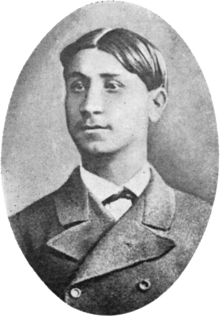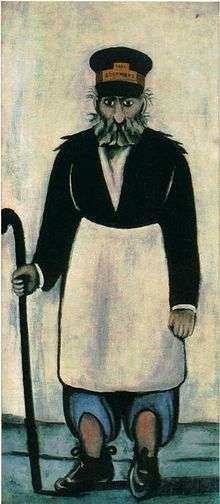Niko Pirosmani
| Niko Pirosmani | |
|---|---|
 Pirosmani, 1880 | |
| Born |
Nikoloz Aslanis Dze Pirosmanashvili 5 May 1862 Mirzaani, Kakheti, Georgia Russian Empire |
| Died |
9 April 1918 (aged 55) Tbilisi, Transcaucasian Democratic Federative Republic |
| Resting place | unknown |
| Nationality | Georgian |
| Education | Self-taught |
| Known for | Painting |
| Movement | Naïve art |
| Spouse(s) | unmarried |
Niko Pirosmani (Georgian: ნიკო ფიროსმანი), simply referred to as Nikala (ნიკალა) (1862–1918), was a Georgian primitivist painter who posthumously rose to prominence.
Biography
Pirosmani was born in the Georgian village of Mirzaani to a peasant family in Kakheti province. His parents, Aslan Pirosmanashvili and Tekle Toklikishvili, were farmers, who owned a small vineyard, with a few cows and oxen. He was later orphaned and left in the care of his two elder sisters, Mariam and Pepe. He moved with them to Tbilisi in 1870. In 1872, while living in a little apartment not far from Tbilisi railway station, he worked as a servant to wealthy families and learned to read and write Russian and Georgian. In 1876, he returned to Mirzaani and worked as a herdsman.
Pirosmani gradually taught himself to paint. One of his specialties was painting directly into black oilcloth. In 1882, with self-taught George Zaziashvili, he opened a painting workshop, where they made signboards. In 1890, he worked as a railroad conductor. In 1893, he co-founded a dairy farm in Tbilisi, which he left in 1901. Throughout his life, Pirosmani, who was poor, was willing to take ordinary jobs including housepainting and whitewashing buildings. He also worked for shopkeepers in Tbilisi, creating signboards, paintings, and portraits, according to their orders. Although his paintings had some local popularity (about 200 survive) his relationship with professional artists remained uneasy; making a living was always more important to him than aesthetic abstractions.
In April 1918, he died of malnutrition and liver failure. He was buried at the Nino cemetery; the exact location was not registered and is unknown.
Work

Pirosmani’s paintings were influenced by the social conditions of his time and place. There are many works about merchants, shopkeepers, workmen, and noblemen groups. Pirosmanashvili was fond of nature and rural life. He rarely employed city landscapes. He made many animal paintings. He was the only Georgian animalist. Pirosmani also was attracted by historical figures and themes such as Shota Rustaveli, Queen Tamar, Giorgi Saakadze, as well as ordinary Georgian people and their everyday lives.
Usually, Pirosmani painted on oilcloth. Unlike other artists, Niko didn’t aim at a pure imitation of the nature and paid no attention to details. Some of his paintings are monochrome. His paintings demonstrate the author's sharp compositional consideration. Placements of the figures are frontal, while faces do not demonstrate a specific mood.
In the 1910s, he won the enthusiasm of the Russian poet Mikhail Le-Dantyu and the artist Kirill Zdanevich and his brother Ilia Zdanevich. Ilia Zhdanevich wrote a letter about Pirosmani to the newspaper Zakavkazskaia Rech, which it published on February 13, 1913. He undertook to publicise Pirosmani's painting in Moscow. The Moscow newspaper Moskovskaia Gazeta of 7 January wrote about the exhibition "Mishen" where self-taught painters exhibited, among them four works by Pirosmani: "Portrait of Zhdanevich", "Still Life", "Woman with a Beer Mug", and "The Roe". Critics writing later in the same newspaper were impressed with his talent.
In the same year, an article about Niko Pirosmani and his art was published in Georgian newspaper Temi.
The Society of Georgian Painters, founded in 1916 by Dito Shevardnadze, invited Pirosmani to its meetings and began to take him up, but his relations with the society were always uneasy. He presented his painting "Georgian Wedding" to the Society. One of the members published a caricature of him, which greatly offended him. His continuing poverty, compounded by the economic problems caused by the First World War, meant that his life ended with his work little recognised.
Posthumous reputation

Niko Pirosmanashvili’s paintings were represented at the first big exhibition of Georgian painters in 1918. From 1920, few articles were published about him. Interest in Pirosmani increased in the 1950s. A biographical film and plays were created, and music was composed. His paintings were exhibited in places, including the Soviet Union and Western Europe. A monument was installed in Tbilisi and a museum opened in Mirzaani. Today, 146 of his works are shown in the Art Museum of Georgia and sixteen paintings are exhibited in the Historical-Ethnographic Museum of Sighnaghi.
He developed an international reputation after the war, when he became admired as a 'naïve' painter in Paris and elsewhere. The first book on Pirosmani was published (in Georgian, Russian, and French) in 1926. He inspired a portrait sketch by Pablo Picasso (1972). Exhibitions of his work have been held in Kiev (1931), Warsaw (1968), Paris (The Louvre) (1969), Vienna (1969), Nice and Marseilles (1983), Tokyo (1986), Zurich (1995), Turin (2002), Kiev, Istanbul (2008), Minsk, Vézelay and Vilnius (2008–2009). The paintings have been seen by more than 350,000 viewers.
Pirosmani is depicted on the one Georgian lari bill. The periodic newspaper Pirosmani is published in two languages in Istanbul. In March 2011, it was discovered that the writing on the door of Qvrivishvilebi’s wine-cellar in Ozaani was made by Pirosmani. On 31 May 2011, during an investigation, experts discovered a painting, which proved to be "Wounded Soldier" by Pirosmani. The painting was given to the National Gallery of Georgia.
In literature and song
- Pirosmani is known for the legend of a romantic encounter with a French actress who visited his town; he was deeply in love with her, to demonstrate it he sold his house and bought her enough flowers to fill the square in front of her hotel window (allegedly bankrupting himself). The story became famous when it was recounted in a poem by Andrei Voznesensky, and later into a hit song by Alla Pugacheva, A Million Scarlet Roses (also known as Million Roses).
- In 1970, Georgian Natela Svanidze composed "Pirosmani," a chamber oratorio for reader, contralto, male sextet and instrumental ensemble, including text by Boris Pasternak
In film
- Pirosmani was the subject of a film by Giorgi Shengelaia, made in 1969, that won the Grand Prix at the Chicago Film Festival in 1972.
- Director Sergei Parajanov shot a short film entitled Arabesques on a Pirosmani Theme.
References
- Georgian National Museum, Niko Pirosmani 1862-1918, Tbilisi, 2006. No ISBN.
- «Пиросмани», Э Кузнецов, 1975, Искусство.
External links
| Wikimedia Commons has media related to Niko Pirosmani. |
- Niko Pirosmani Home Page
- Biography and Works of Pirosmani at the Wayback Machine (archived November 23, 2007)
- Biography
- Olga's Gallery: Niko Pirosmani
- A bilingual (Turkish and Georgian) quarterly journal, called Pirosmani is published in Istanbul.
- A contemporary art gallery that exhibits international emerging artists working in painting, photography, glass, ceramics and sculpture called Pirosmani in Istanbul.